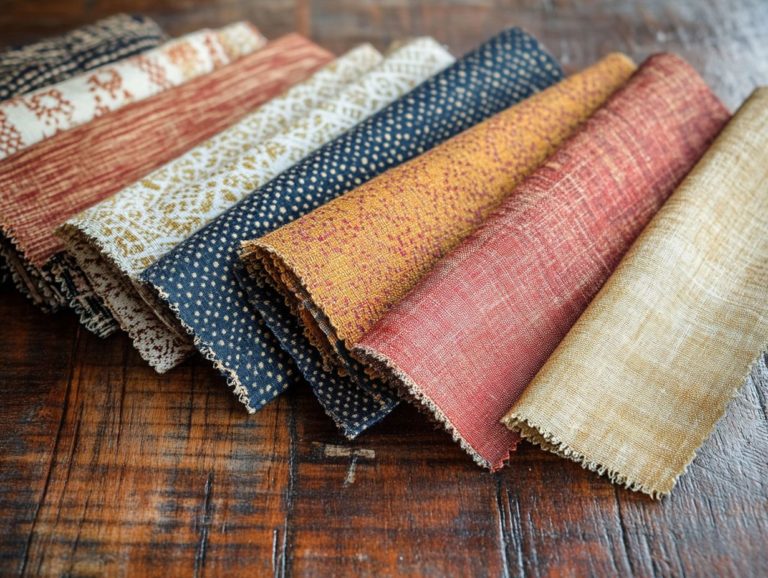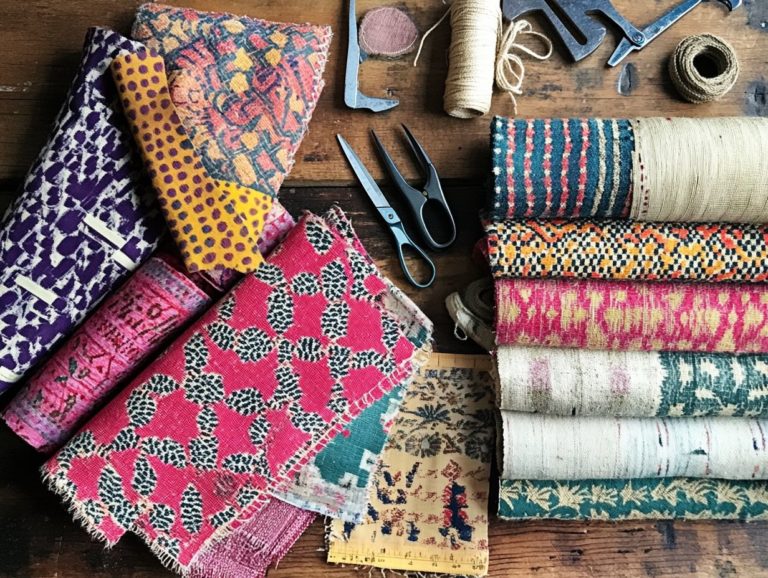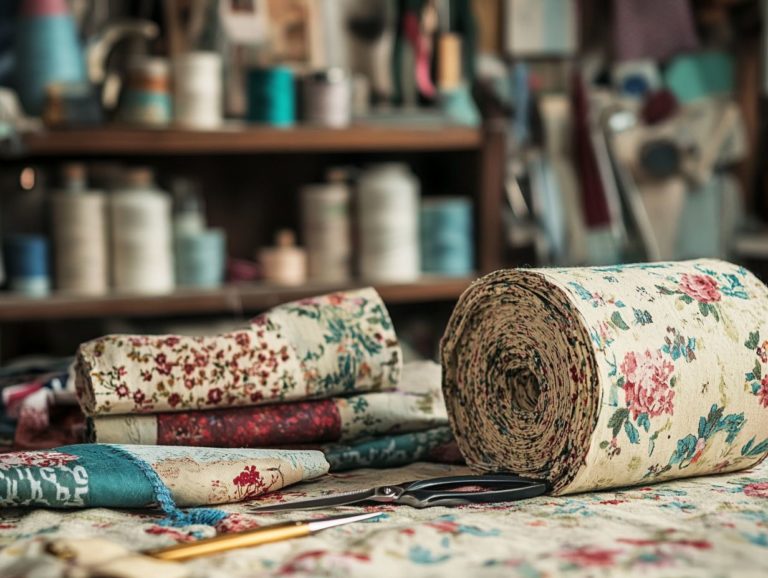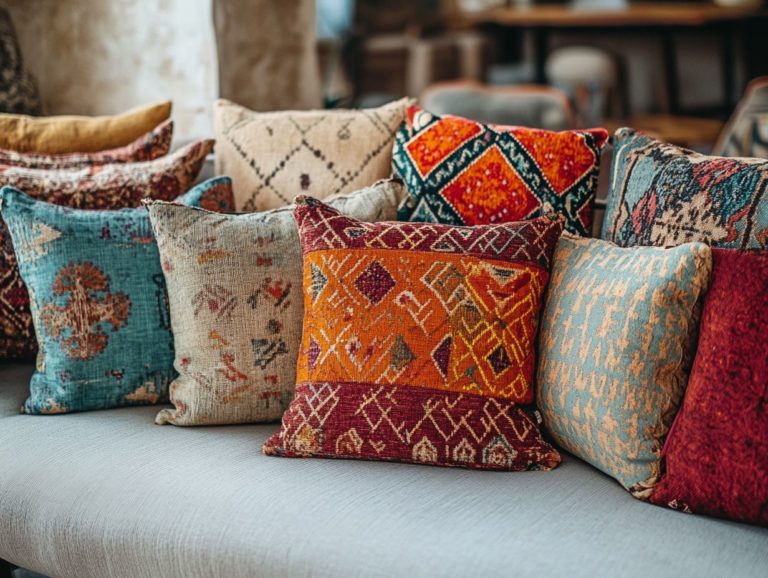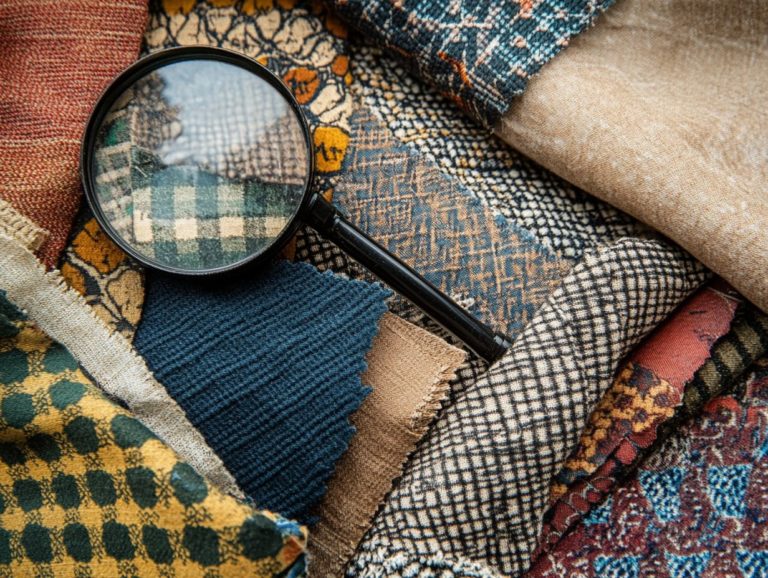5 Tips for Choosing Vintage Fabrics for Projects
Vintage fabrics exude a distinctive charm, enabling you to weave history and character into your projects. Regardless of whether you re a seasoned crafter or just starting your creative journey, understanding the details of vintage textiles (fabrics used for making clothes and other items) can truly elevate your work.
This article presents five essential tips for selecting the perfect vintage fabric, guiding you through recognizing quality and condition while considering colors and patterns that align with your vision. Get ready to elevate your projects to a new level of style!
You will learn where to find these treasures and what qualifies a fabric as “vintage.” Prepare to transform your projects with an air of timeless elegance!
Contents
- Key Takeaways:
- 1. Understand the Different Types of Vintage Fabrics
- 2. Check for Quality and Condition
- 3. Consider the Color and Pattern
- 4. Think About the Project You Have in Mind
- 5. Know Where to Find Vintage Fabrics
- What Makes a Fabric ‘Vintage’?
- Frequently Asked Questions
- What are some important tips for choosing vintage fabrics for projects?
- Where can I find vintage fabrics for my projects?
- What are some popular types of vintage fabrics?
- How should I clean and care for my vintage fabrics?
- Can I mix vintage fabrics with modern fabrics in my projects?
- What are some common mistakes to avoid when choosing vintage fabrics for projects?
Key Takeaways:
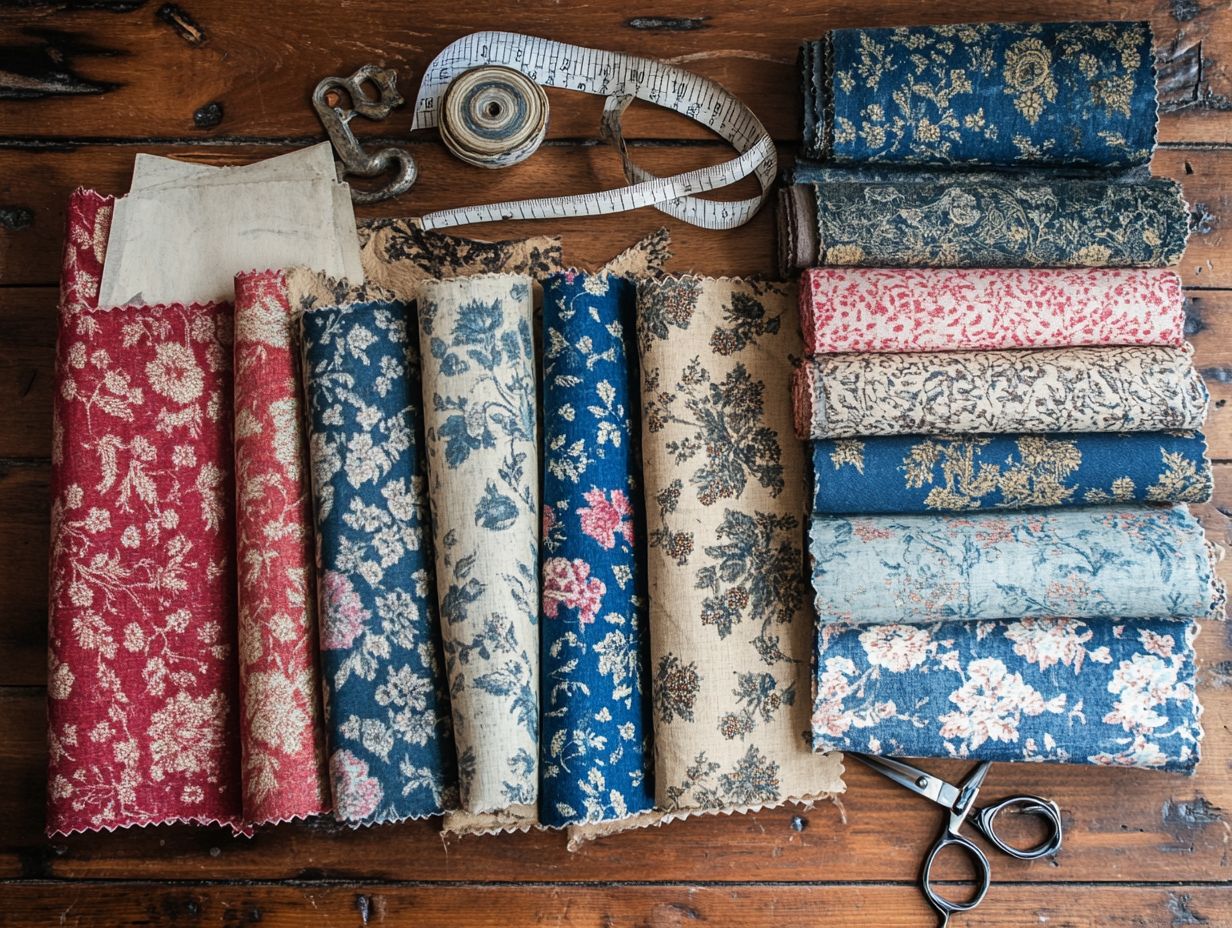
- Understand the different types of vintage fabrics to choose the right one for your sewing projects.
- Check the quality and condition of vintage fabrics to ensure they will hold up in your project.
- Choose colors and patterns that fit your overall design aesthetic.
1. Understand the Different Types of Vintage Fabrics
Understanding the various types of vintage fabrics is crucial for any fabric enthusiast like you. Each era offers unique characteristics and styles that reflect the fabric’s history and cultural significance.
From the vivid prints of 1960s floral designs to the luxurious textures of 1950s upholstery, each fabric tells a story, bridging the past with your contemporary fabric choices. Take the 1940s tropical fabrics, for example; they evoke a sense of adventure and nostalgia.
Meanwhile, the bold 1970s polyester highlights the era’s embrace of synthetic materials. By diving into these vintage styles, you can uncover one-of-a-kind pieces that will not only enhance your fabric collection but also inspire your sewing projects.
Consider the fond memories many fabric enthusiasts have of their grandmother’s beautifully tailored dresses made from soft, flowing rayon. This fabric was all the rage in the early 20th century. Then there’s the iconic Liberty print from Britain, renowned for its intricate floral designs, which has since become a staple for modern quilters.
The beauty of these vintage materials lies not only in their distinctive aesthetics but also in the compelling stories they carry tales of craftsmanship and evolving societal values.
Today, designers like Anna Maria Horner and Tula Pink draw from this rich history, showcasing how these fabrics can effortlessly blend into contemporary collections, whether in a handcrafted bag or stylish home decor item. Embrace this journey into vintage fabrics, and you might just find the inspiration you’ve been seeking.
2. Check for Quality and Condition
When you’re diving into the world of vintage fabrics, it s essential to focus on quality and condition. By doing so, you’re investing in materials that not only look stunning but also stand the test of time.
A careful examination can unveil crucial details like fabric weight, durability, and potential red flags such as discoloration or wear, which can significantly influence your fabric selections. Remember, high-quality fabrics enhance the longevity of your sewing projects.
It s vital to spot any signs of damage or degradation that might undermine the fabric’s integrity. Each piece tells a story, and preserving these unique fabrics demands your diligence and care.
To assess quality, pay attention to the texture; a luxurious hand and sturdy weave often signal exceptional craftsmanship. Fabric weight matters too heavier fabrics tend to be more robust, while lighter ones can be delicate, yet equally precious.
Keep an eye out for fading, which may indicate excessive sun exposure, as well as spots or stains that suggest neglect. Don t overlook fraying edges, as they hint at wear and tear; inspecting seams closely can reveal a lot.
Regarding maintaining the perfection of vintage fabrics, cleaning them appropriately is key think cold water for delicate items. Organizations like the American Vintage Society champion sustainable fabric care practices, highlighting the importance of preservation of fabrics for future generations.
Following their guidelines will help ensure your vintage treasures remain in impeccable condition.
What vintage fabric stories do you have to share? Share your vintage fabric treasures and how you used them in your projects!
3. Consider the Color and Pattern
The color and pattern of vintage fabrics significantly shape their visual appeal, influencing not just the visual impact of your projects but also the feelings you form with these unique fabrics.
From the striking geometric prints of the 1960s floral to the vibrant colors of 1970s polyester, each pattern tells a story and evokes a specific mood tied to fabric memories. When you’re selecting fabrics, consider how these elements can enhance your projects while reflecting your personal style and the atmosphere you wish to create.
To truly appreciate this influence, take a moment to explore how color trends have evolved over the decades. Each era showcases unique palettes that resonate with cultural changes and art movements. For example, the soft pastels of the 1950s evoke a sense of calm and nostalgia, making them perfect for projects designed to cultivate soothing environments. In contrast, the bold, saturated colors of the ’80s symbolize spirited self-expression and adventure.
Understanding color psychology the study of how colors affect feelings gives you the power to select fabric swatches that not only align with your vision but also elicit the emotional responses you desire. Today, many contemporary designers, like Marimekko and Anna Sui, draw inspiration from these vintage aesthetics, expertly weaving old-fashioned styles into modern designs.
This fusion creates timeless collections that appeal to a broad audience, blending nostalgia with innovation for a fresh take on classic style.
4. Think About the Project You Have in Mind
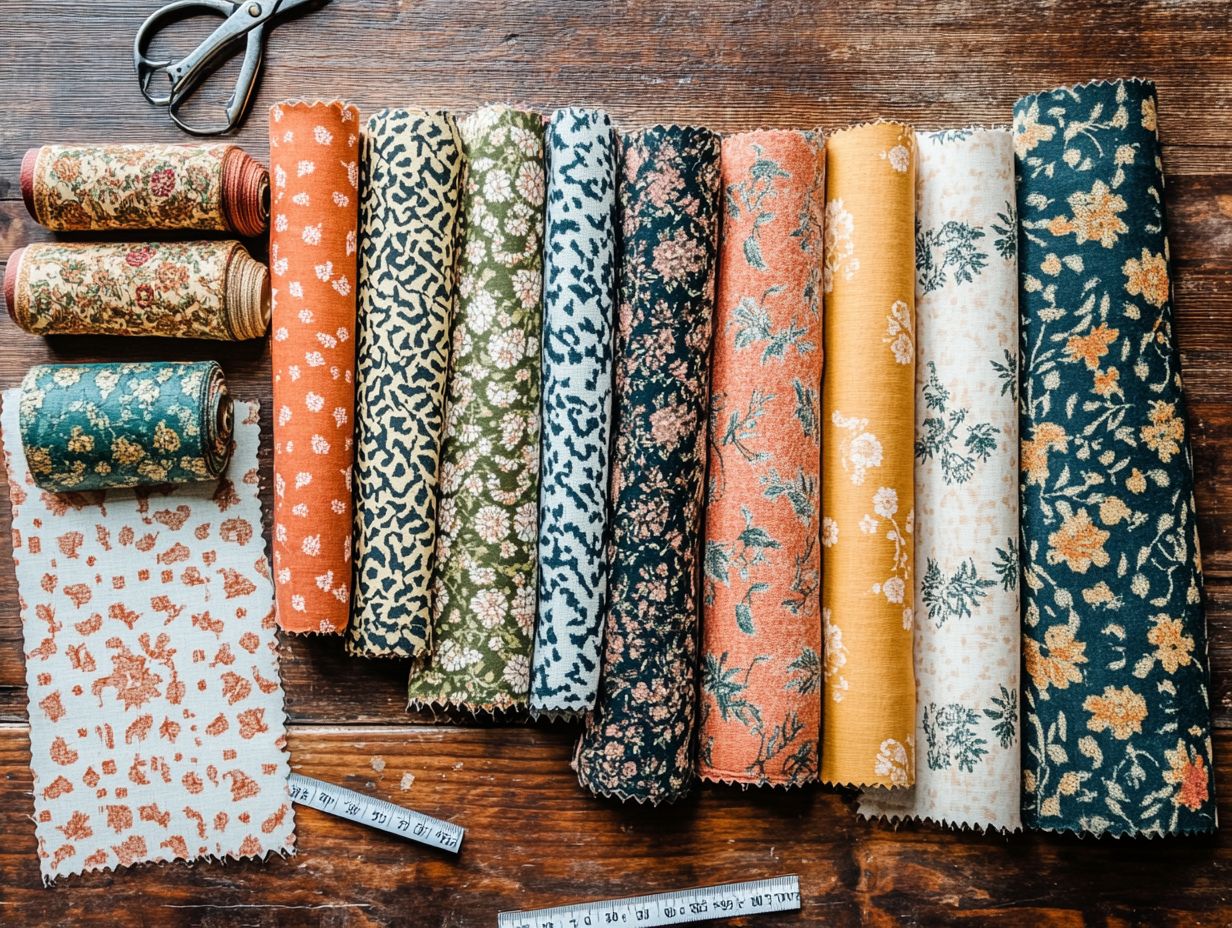
When you contemplate the project you have in mind, it’s crucial to consider the unique characteristics of vintage fabrics. These can profoundly influence the outcome of your sewing endeavors. Consider how the fabric s weight, texture, and pattern align with the design requirements of your project, whether you’re crafting a handmade garment or a stunning home decor piece.
Vintage fabrics come with intricate details and stories woven into them. Taking a thoughtful approach to fabric selection is essential. To learn more about where to find authentic vintage fabrics, you can honor their legacy while helping you achieve your desired aesthetic.
By striking a balance between creativity and practicality, you can produce truly unique and beautiful pieces that resonate with your appreciation for fabric. Different types of vintage fabrics, like soft cottons, luxurious silks, or durable canvas, can be sourced by choosing the right vintage fabrics for your home, catering to a variety of projects and preferences.
For instance, lightweight cottons are perfect for summer dresses, offering breathability and comfort, while heavier fabrics provide the structure and warmth needed for jackets and coats. As you choose, consider how each fabric’s durability will withstand the test of time, especially for garments intended for daily wear.
Don t overlook the emotional connections that certain patterns or textures can evoke. A floral print might remind you of a cherished grandmother s garden. By tapping into these memories, you can infuse new life into each piece, allowing your creations to tell a personal story.
5. Know Where to Find Vintage Fabrics
Knowing where to find vintage fabrics is essential for anyone who wants to elevate their collection with unique pieces that embody style and sustainability. From specialized shops like Lady Virginia Vintage to hidden gems in thrift stores, a world of one-of-a-kind fabrics awaits, each telling a story steeped in rich history.
Understanding the salvage economy encourages sustainable practices, allowing you to indulge your passion for fabrics while positively impacting the environment. With the right knowledge, you ll be ready to unearth treasures that inspire your sewing projects!
Exploring online platforms such as Etsy, eBay, and vintage fabric-specific websites can reveal a stunning array of textiles, from luxurious silks to durable denims. Local fabric shops are also key in this pursuit, often stocking locally sourced materials created by artisans committed to sustainability.
Engaging in this fabric quest enriches your collection and deepens your connection to the artisans behind these materials. And the best part? Sharing your fabric-hunting adventures can inspire others and create a vibrant community filled with treasured finds!
What Makes a Fabric ‘Vintage’?
A fabric is considered ‘vintage’ when it embodies characteristics of a specific era, often stirring nostalgia and capturing the essence of past textile history. This can significantly shape today s fabric trends and reflect the impact of industrialization.
To qualify as vintage, a fabric typically needs to be at least 20 years old, showcasing styles that define particular decades. Think bold geometric prints from the 1980s or delicate lace accents from the 1920s! You can explore unique uses for vintage fabrics in home decor to get inspired!
Materials like denim, silk, and cotton have played pivotal roles during these periods, intertwining with social movements and cultural revolutions. For instance, the rise of utilitarian fabrics during World War II paved the way for modern minimalist designs.
By preserving these vintage textiles, you enable future generations to appreciate the craftsmanship of the past. This preservation sparks conversations about sustainability in the fabric industry while honoring historical roots.
What Are the Most Popular Types of Vintage Fabrics?
The most popular types of vintage fabrics weave a rich tapestry of styles and materials that resonate with the aesthetic preferences of their eras, making them highly coveted by collectors and crafters alike.
- The funky geometric prints of the 1960s added a quirky flair to cushions and curtains!
- The opulent brocades of the Victorian era evoke a sense of grandeur and romance.
These distinctive characteristics guide your choices and spark cherished memories. This connection links you intimately to the past while fueling your inspiration for new creations.
How Can You Tell If a Vintage Fabric Is High-Quality?

Determining whether a vintage fabric is high-quality involves assessing various factors, including its physical properties, construction techniques, and overall condition. These elements can significantly impact both its aesthetic appeal and durability.
High-quality vintage fabrics often showcase exquisite craftsmanship, reflecting meticulous attention to detail in the weaving process and material selection. Spotting these traits can empower you to choose fabrics wisely!
It s crucial to pay close attention to material composition. Top-tier fabrics are typically crafted from natural materials like cotton, linen, or silk. These materials provide an authentic vintage feel while offering superior breathability and durability.
Lower-quality fabrics often contain synthetic blends, which can lead to issues such as pilling or fading over time. To evaluate the condition and durability of potential purchases, examine the fabric closely for any signs of wear, such as fraying edges or discoloration. Take a moment to feel its texture, as this will help you gauge its resilience.
Armed with this knowledge, you have the power to curate a collection that stands the test of time.
Knowing what to look for sets the stage for incorporating these fabrics into your modern designs.
What Are Some Common Issues to Look for in Vintage Fabrics?
When shopping for vintage fabrics, it s crucial to be mindful of common issues that could impact their usability and overall aesthetic. These issues can affect your choices.
Problems like fading, discoloration, and damage to the fabric can undermine the integrity of these unique fabrics, so conducting thorough inspections before making a purchase is essential.
By addressing these concerns through proper care, you not only preserve the historical value of vintage fabrics but also ensure they remain viable options for your sewing projects.
For instance, fading often sneaks in from prolonged exposure to sunlight, resulting in uneven patches that can diminish the fabric s charm. Examine the fabric under various lighting conditions to spot this issue. Discoloration might manifest as stains or altered color hues, so careful inspection is necessary to catch these early. Damage, such as fraying edges or moth holes, can compromise the material’s durability.
To remedy these issues, consider the following approaches:
- Use UV-filtering window treatments to shield fabrics from sunlight.
- Opt for gentle, chemical-free cleaning methods to maintain their integrity.
- Employ basic sewing skills to mend minor damages.
By embracing these practices, you can enjoy your vintage fabrics for years to come while ensuring they retain their timeless appeal.
How Can You Incorporate Vintage Fabrics into Modern Projects?
Incorporating vintage fabrics into your modern projects allows you to blend the charm of bygone eras with contemporary aesthetics, resulting in unique and captivating creations.
Imagine using a bright retro floral fabric as an accent on your sofa to create a striking visual contrast, or repurposing an elegant lace tablecloth into a chic table runner. It s vital to align your fabric choices with current color palettes and design trends for seamless integration.
Successful projects like patchwork quilts that feature vintage swatches alongside modern materials demonstrate how this fusion can yield visually stunning results while honoring the craftsmanship of the past. By exploring various application techniques, such as upholstery (the craft of covering furniture with fabric) or clothing alterations, you can reimagine these timeless textiles in a way that feels fresh and relevant today.
Get creative and start exploring the beautiful world of vintage fabrics today!
What Are Some Tips for Sourcing Vintage Fabrics?
Sourcing vintage fabrics can truly be an exhilarating endeavor, brimming with unique opportunities. You can uncover pieces that not only reflect your personal style but also carry history. It s essential to approach this search with a strategic mindset.
By exploring various avenues, such as local fabric shops, thrift store treasures, and online marketplaces, you can unearth hidden gems that tell a story. These finds will fuel innovation for your next sewing project.
Developing a discerning eye for quality and understanding the subtleties of vintage fabrics will enhance your selection process. This leads to a more rewarding fabric journey.
Engaging with the local fabric community will boost your sourcing experience. Attend fabric swaps or join sewing groups to open up valuable networking opportunities.
Online platforms, including social media and vintage fabric forums, are treasure troves. Here, you can discover rare finds and connect with fellow enthusiasts.
Patience is key in this pursuit. Vintage fabrics can be scattered and take time to uncover. Keep searching! Regularly check various sources for the best finds, ensuring that each fabric acquisition becomes a meaningful addition to your collection.
Frequently Asked Questions
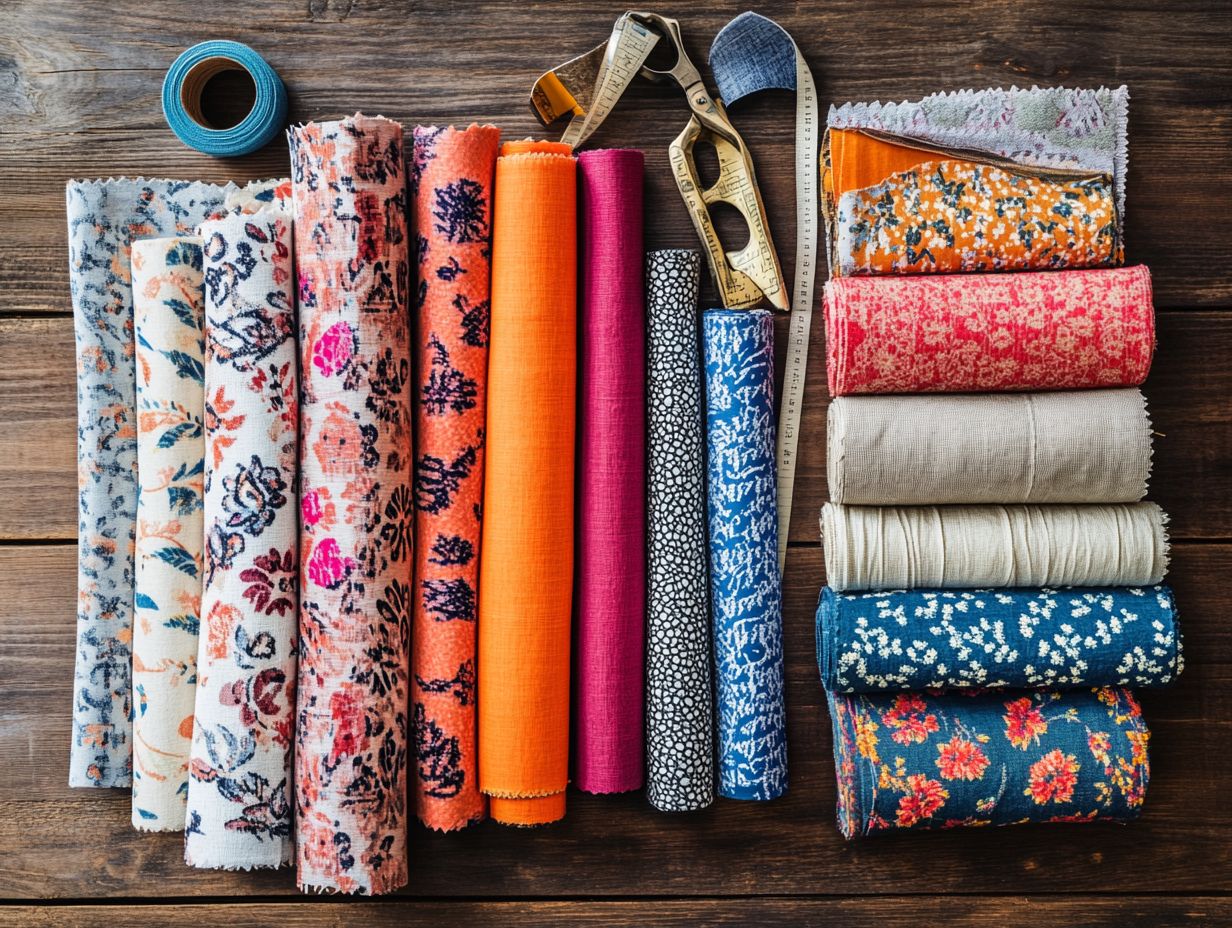
What are some important tips for choosing vintage fabrics for projects?
- Consider the fabric’s condition: When choosing vintage fabrics, carefully examine them for any stains, tears, or signs of wear. This may affect the overall quality of your project.
- Research the era: Vintage fabrics vary in style and design depending on the era they were produced. Do your research and consider the look and feel you’re aiming for with your project.
- Check for authenticity: With the rising popularity of vintage fabrics, many reproductions and fakes are on the market. Purchase from reputable sellers and ask for proof of authenticity if possible.
- Consider the project’s purpose: Different fabrics are better suited for specific projects. For instance, if you’re making a dress, you may want a lightweight and flowy fabric, while upholstery may require a heavier, more durable option.
- Test for colorfastness: Colorfastness means the colors won’t bleed or fade when washed. Test a small piece of fabric before using it to avoid any unexpected color changes.
Where can I find vintage fabrics for my projects?
You can find vintage fabrics in many places, including thrift stores, flea markets, antique shops, and online marketplaces. Reach out to local sewing or quilting groups, as they may have members selling or swapping vintage fabrics.
What are some popular types of vintage fabrics?
Popular types of vintage fabrics include cotton, linen, silk, and wool. These fabrics were commonly used throughout the years and can often be found in good condition.
How should I clean and care for my vintage fabrics?
Be gentle when cleaning and caring for vintage fabrics, especially unique ones. Handwashing is often recommended, using mild detergent and cold water to help preserve the fabric’s colors and fibers.
Avoid using bleach or harsh chemicals, and air dry or use a low heat setting if machine drying is necessary.
Can I mix vintage fabrics with modern fabrics in my projects?
Absolutely! Mixing vintage and modern fabrics can create a unique and eclectic look. Just be sure to consider the weight, colors, and patterns to ensure they complement each other.
What are some common mistakes to avoid when choosing vintage fabrics for projects?
Avoid common mistakes such as not checking for authenticity, overlooking the fabric’s condition, and failing to research the era. It’s also important not to overpay for fabrics and to test for colorfastness before using them in a project.

